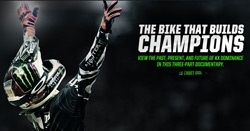
There has
very rarely been an executive from the car business who has jumped from four wheels to two. Last year, auto vet Richard Beattie -- who had been EVP of marketing and sales at Jaguar Land Rover and most
recently, chief commercial officer at high-end electric car maker Fisker -- joined Kawasaki Motors Corp. U.S.A. as chief marketing and sales officer. Beattie talks to
Marketing Dailyabout plans
to invest big in marketing -- especially digital and experiential -- and to boost brand differentiation and get people interested in riding.
Q: What are the big differences, from a marketing
perspective, between two wheels and four?
A: They are obviously different in terms of products and customers, but the processes are also very similar. We were bringing a complicated
piece of equipment to market in the most competitive and open market in the world. I marketed luxury automobiles, so the passion in that part of the auto market is also very similar to
motorcycles.
advertisement
advertisement
Q: What are key marketing challenges?
A: All the different products and all the customers we are trying to communicate to. We have a very diverse
product line -- from motorcycles to four wheelers to jet skis -- and a very diverse customer base.
Q: And the safety issue when it comes to bringing in new customers who might be a
bit skittish about riding?
A: That's always going to be a challenge. The fact is, you will never get away from the need to balance on two wheels, and the fact that it's not you
that's the challenge, but the guy who can't see you. I think new safety technology on cars, including proximity warnings [on cars and bikes] will help change that. I think we and the [Motorcycle
Industry Council] have to do something more to attract younger riders and make riding safer.
Q: As gas prices go up, though, won't you get a natural influx of consumers?
A: The economic fundamental is that, as gas prices increase, the attractiveness of motorcycles improves. But as gas prices increase, people also have less money to spend on motorcycles. So
there are many factors.
Q: You've talked about differentiating Kawasaki from the other Japanese brands. Harley-Davidson has done a great job with creating a real brand identity. Can
you learn from that?
A: Harley-Davidson has 65% of the market, and they've done that partly by offering a lifestyle first and product second, but that is decades in the making. The
right approach is to decide what you stand for and do it better than anybody else. And make sure you put money where your mouth is in engaging customers.
Q: How can Kawasaki do that, though,
since you haven't been in the U.S. long enough to have established that kind of value?A: Ownership experience is the key. Harley-Davidson has been very good at that with its
Harley-Davidson Owners Groups (HOG). It's not just buying a bike, but what can we do for you as you engage with us; what resonates with you? We have our Riders of Kawasaki, “ROK”;
I’d like to expand that, and make it far more experiential. Marketers think social networks are enough to create experience, but there's not much personal interaction with that. To my mind, only
by overlaying that social network with our products can we grow true social interactions with consumers.